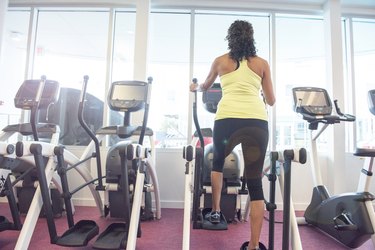
Climbing stairs helps strengthen your cardiovascular system (heart and lungs) and various muscles throughout your body. And whether you want to lose weight, build muscle or improve your heart health, taking a turn on the stair climber can help you reach your goals.
To fully reap the benefits of this type of exercise, aim for at least 150 minutes of moderate aerobic exercise, like stair climbing, each week, according to the Physical Activity Guidelines for Americans.
Video of the Day
Video of the Day
1. Glutes
The gluteus maximus is the largest muscle of the gluteal muscle group, which also contains the gluteus medius and gluteus minimus, according to Physiopedia. The gluteus maximus is the primary hip extensor, helping to lift your body as you press downward with one leg at a time while exercising on a stair-climbing machine.
The muscle attaches to the back, inside portion of the pelvis and runs diagonally downward, reattaching to the back, upper portion of the femur, or thigh bone. The gluteus maximus is also active during common activities such as bending over, squatting down, standing up, and walking or running.
2. Hamstrings
The hamstrings are a group of three muscles — the biceps femoris, semimembranosus and semitendinosus — that span the back of your thighs, crossing both the hip and knee joints, per Physiopedia. They are the primary knee flexors and help the gluteus maximus extend your upper legs. They work almost constantly, therefore, as you're training on a stair-climbing machine.
For example, the hamstrings on your left leg contract to help extend your hip as you're pressing down with your left foot at the same time that the hamstrings on your right leg contract to flex your knee as you're lifting your right foot and vice versa.
3. Quadriceps
The quadriceps (quads) are a group of four muscles — the rectus femoris, vastus intermedius, vastus lateralis and vastus medialis — that span the front of your thighs, opposite your hamstrings, according to Physiopedia.
Accordingly, they facilitate the opposite range of motion — knee extension -—and the rectus femoris also helps flex your hip joint.
The quads contract powerfully to extend your knee each time you press your foot down when you're using a stair-climbing machine. The rectus femoris also works to lift your upper leg during the exercise, along with the other hip flexors.
4. Abdominal Muscles
The abdominal muscles include the rectus abdominis in front, the external and internal obliques on the sides and the transversus abdominis, which wraps around your abdomen underneath the others, per Physiopedia.
These muscles allow you to move your spine through various ranges of motion, but not as you're climbing stairs. Rather, they work to stabilize and support your spine, helping you maintain balance and remain upright as you move your hips and knees through the extension and flexion ranges of motion required to exercise on a stair-climbing machine.